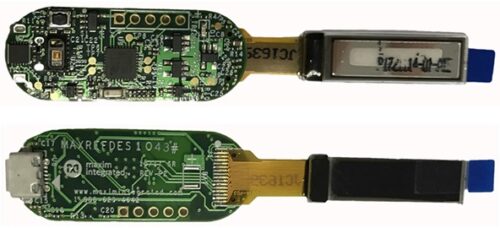A SpO2 reference design utilises a biosensor for non-invasive blood oxygen level measurements, focusing on accuracy and efficiency.

A pulse oximeter is a non-invasive medical device fundamentally designed to measure the blood’s oxygen saturation level (SpO2) and heart rate. This measurement is crucial for assessing how effectively oxygen is transported to the body’s extremities, making it an essential tool in various healthcare environments. It is precious for monitoring individuals with heart or respiratory conditions, as it aids in promptly detecting oxygenation problems and facilitating timely medical interventions.
The MAXREFDES1043, a reference design from Analog Devices (ADI) utilising Maxim’s next-generation MAX30102 biosensor, is engineered for SpO2 measurements. This design boasts high accuracy, low power consumption, compact size, and easy implementation for monitoring SpO2 levels with red and IR LEDs. The MAX30102 module combines pulse oximetry and heart-rate monitoring functionalities, featuring integrated LEDs, photodetectors, optical components, and low-noise electronics with ambient light rejection capabilities. It offers a comprehensive solution that simplifies integration into mobile and wearable devices. The module operates with a 1.8V power supply and a separate 3.3V supply for its internal LEDs. It communicates via a standard I2C-compatible interface and includes a software-controlled shutdown feature with zero standby current, allowing the power rails to be continuously powered.
This integrated solution stands out for its small size, low power consumption, and high accuracy. Combining these features and benefits in a single package offers a compact and efficient design that is ideal for applications where precision and minimal power usage are critical. The integration of these elements results in a streamlined and effective product.
The reference design includes the MAX3010x series, which provides a comprehensive optical-module solution that simplifies the design process for mobile and wearable devices in both the fitness and health sectors. The MAX30101 and MAX30102 models function similarly, with the primary distinction being the types of LEDs they use.
Pulse oximetry offers a non-invasive approach to measuring blood oxygen saturation levels in individuals. These levels indicate the proportion of oxygenated haemoglobin to total haemoglobin in the blood and are crucial for identifying conditions like hypoxemia, declining organ function, and potential cardiac arrest. The MAX3010x series provides a vital non-invasive method for monitoring these oxygen saturation levels, highlighting its medical significance. Moreover, pulse oximetry inherently produces a heart-rate signal, enabling users of the MAX30101 also to acquire this vital information.
In this design, LEDs emit light at specific wavelengths that pass through tissue and are absorbed by photodetectors on the opposite side. The variation in absorption of these wavelengths is crucial in determining oxygen saturation levels. A thin test site with sufficient blood flow, such as a finger or earlobe, is necessary for optimal light transmission.
ADI has tested this reference design. It comes with a Bill of Material (BOM), schematics, printed circuit board (PCB) layout, etc. You can find additional data about the reference design on the company’s website. To read more about this reference design, click here.








